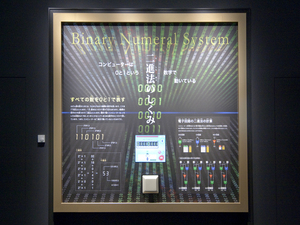Nagoya City Science Museum
TOP > Exhibition Guide > Floor Map> Binary Numeral System
Binary Numeral System



Purpose of Exhibition
We adopted the "decimal numeral system" which represents numbers using 10 kinds of number from 0 to 9. On the other hand, computers are based on a principle called "the binary numeral system" which uses only two kinds, "0 and 1"that are used for turning on and off electric signals. In this exhibit, the decimal numeral system and the binary numeral system can be experienced and understood easily.
Additional Knowledge
Bit
In computers, power is turned on and off.
It can be said that a computer is operated by binary numeral system since the numbers 0 and 1 can be used to turn on and off the computer. The Binary numeral system is a method which represents numbers using only 2 kinds of numbers (0 and 1 in this case). The number of digits is called "bit". The first computers needed many cables to process digits. That is because the number of digits reflected the number of cables required.
As personal computers became common in the middle of the 1980s, the CPU (Central Processing Unit) had been evolving from the 8-bit with 8 cables to 16-bit.
Hexadecimal numeral system
Although the binary numeral system is convenient for computers, many digits are required to represent large numbers. For example, in order to represent the numbers from 0 to 1023, for example, the number of digits will be from"0"to "1111111111", which results in 10 digits. In other words,"10 bits" are also required. This is inconvenient for us, therefore the hexadecimal numeral system has been adopted. It is a method that represents the numbers using a total of 16 kinds of characters from "0"to "9"and from "A" to "F". For example, 9 plus 1 equals "A" and 1 added to the "A" equals "B". When the addition continues and reaches "F", the following is "10". Although the decimal numeral system that we normally use is 10, "10"of the hexadecimal numeral system is 16. "0x" is sometimes added in front so as to avoid confusion, For example, "0x36" is "36"of the hexadecimal numeral system and 54 in the decimal numeral system. In case of two digits in the hexadecimal numeral system, from "0x0"to "0xFF", the number from 0 to 65535 in the decimal numeral number can be represented. (Figure1)
Byte Hexadecimal numbers and binary numbers are compatible and 4 digits of the binary number can exactly be represented in one digit of the hexadecimal number. For example, "1011"out of "10110101" in the binary number is "B" in the hexadecimal number. And "0101"is "5"in the hexadecimal number. Thus it becomes "0xB5". Since it is convenient to represent the characters in unison as 8 digits, every 8 bits have been put together. This is called a"Byte".
CPU
The bit number of a CPU stands for how big numbers can be used at a time. (Figure 1) Although numbers bigger than 256 can be calculated by a computer with 8 bits, it takes a lot of time to calculate the big numbers because various tricks are required in programming. The bigger the bit number is, the faster the computer is. That is because it needs no tricks to calculate directly. Currently, the bit number is changing from 32 to 64. How much faster will it become in the future?
Table 1: Example of how to represent numbers
| Decimal | Binary | Hexadecimal |
|---|---|---|
| 0 | 0 | 0 |
| 50 | 110010 | 32 |
| 255 | 11111111 | FF |
| 1024 | 10000000000 | 400 |
| 65535 | 1111111111111111 | FFFF |
Table 2:Bit and Number Capacity
| Bits | Capacity |
|---|---|
| 8 | 0 - 255 |
| 16 | 0 - 65535 |
| 32 | 0 - approximately 4.2 billion |
| 64 | 0 to about one billion times larger than 18 billion |
Article by Tetsuro Ojio, curator
